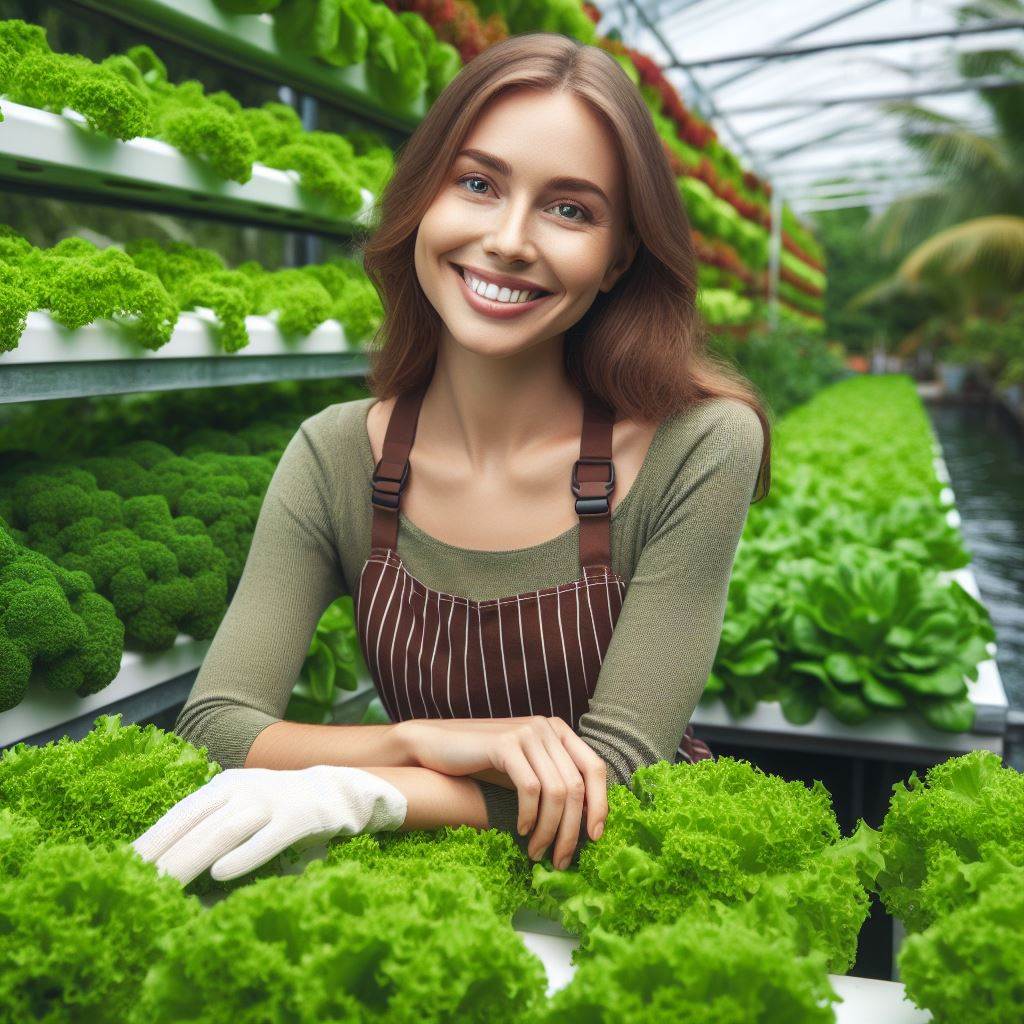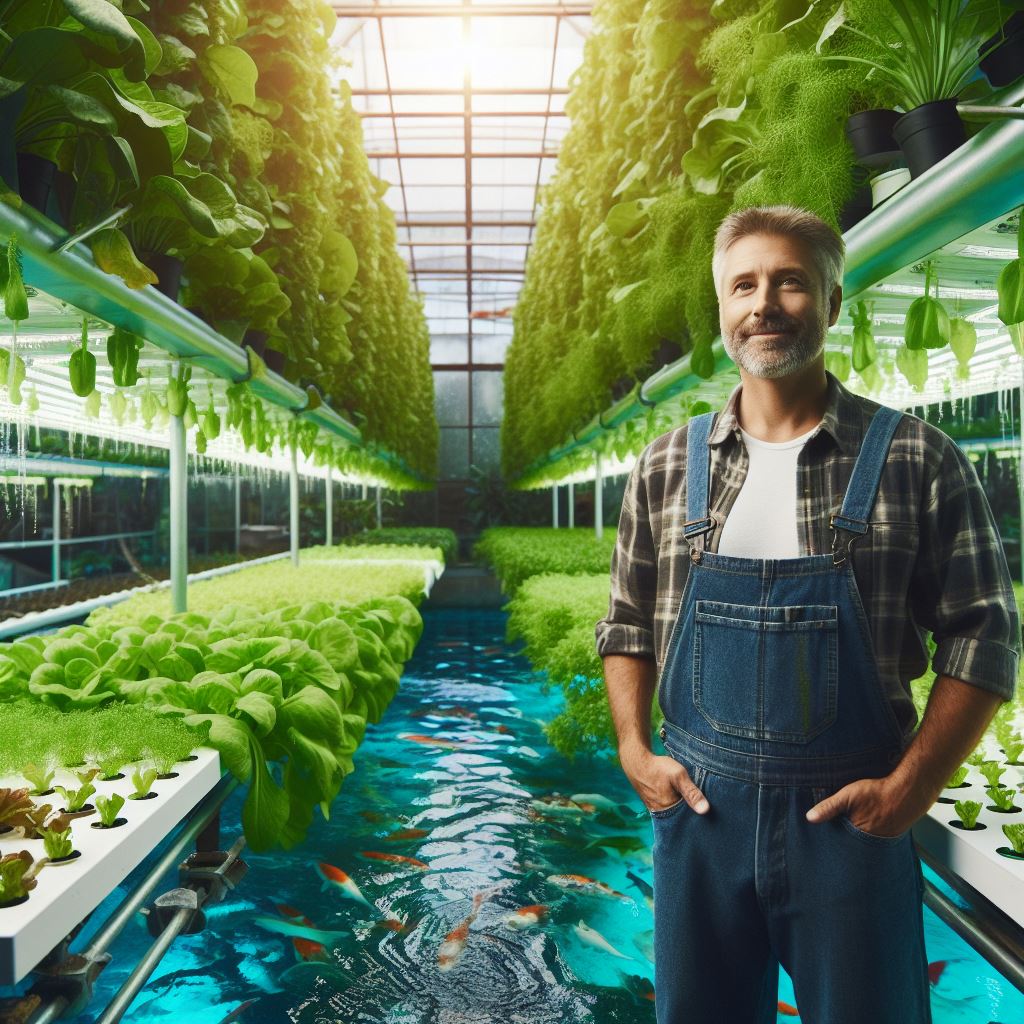Introduction
Definition of aquaponic systems
Aquaponic System Tips: Embrace a sustainable approach by integrating plant cultivation and fish farming within aquaponic systems.
These systems rely on a delicate balance between the fish, plants, and bacteria.
Maintaining this balance is crucial for the success of the system.
The term “aquaponics” combines two words: “aquaculture” and “hydroponics.”
Aquaculture refers to the practice of cultivating fish in a controlled environment, while hydroponics refers to growing plants without soil, using nutrient-rich water instead.
In aquaponic systems, these two techniques are combined to create a symbiotic relationship between the fish and plants.
Importance of maintaining a balance in these systems
Maintaining a balance in aquaponic systems is vital because the fish produce waste that contains high levels of ammonia.
This ammonia is harmful to the fish but can be beneficial to the plants.
Bacteria in the system convert the ammonia into nitrates, which serve as nutrients for the plants.
In turn, the plants help to filter the water for the fish by absorbing the nitrates.
If the balance in an aquaponic system is disrupted, it can have detrimental effects on both the fish and plants.
For example, if there are too many fish and not enough plants, the ammonia levels can become toxic, leading to fish stress or even death.
On the other hand, if there are too many plants and not enough fish, the plants may not receive enough nutrients, leading to stunted growth.
To maintain the balance in aquaponic systems, regular monitoring of water parameters such as pH, ammonia levels, and temperature is essential.
Adjustments can be made by adding or removing fish or plants as needed.
Transform Your Agribusiness
Unlock your farm's potential with expert advice tailored to your needs. Get actionable steps that drive real results.
Get StartedAdditionally, ensuring proper filtration, aeration, and regular system maintenance are crucial for keeping the system in balance.
Basically, aquaponic systems offer a sustainable and efficient way to grow plants and raise fish.
To ensure their success, maintaining a delicate balance between the fish, plants, and bacteria is paramount.
Regular monitoring and adjustments are necessary to keep the system in harmony and maximize its potential.
Understanding the Components of an Aquaponic System
When setting up an aquaponic system, understanding the components involved is crucial.
Each component serves a specific purpose and plays a vital role in maintaining a balanced and thriving system.
Fish Tank
The fish tank is the heart of the aquaponic system.
It is where the fish reside, and their waste serves as the primary source of nutrients for the plants.
The fish produce ammonia-rich waste, which is converted by bacteria into nitrates that can be absorbed by the plants.
When selecting fish for an aquaponic system, it is essential to consider their compatibility with the system’s requirements.
Commonly used fish species for aquaponics include tilapia, trout, catfish, and goldfish.
These fish are known for their ability to thrive in the system and tolerate fluctuating water conditions.
Grow Bed
The grow bed is where the plants are cultivated.
It is filled with a suitable grow media that supports the plants’ root systems and facilitates nutrient absorption.
The grow bed acts as a biofilter, removing excess nutrients from the water, thus maintaining a healthy environment for the fish.
When selecting a grow media, factors such as water retention, aeration, and pH neutrality should be considered.
Some commonly used grow media for aquaponics include expanded clay pellets, gravel, and coconut coir.
Plumbing System
The plumbing system ensures proper water circulation between the fish tank and the grow bed.
It plays a crucial role in maintaining oxygen levels, nutrient distribution, and waste removal.
Without proper water circulation, both the fish and plants can suffer from oxygen deprivation and nutrient deficiencies.
Various types of plumbing systems can be used in an aquaponic system.
The choice depends on factors such as system size, available space, and personal preferences.
Some commonly used plumbing systems include continuous flood, ebb and flow, and vertical systems.
Each system has its advantages and is designed to meet specific requirements.
Showcase Your Farming Business
Publish your professional farming services profile on our blog for a one-time fee of $200 and reach a dedicated audience of farmers and agribusiness owners.
Publish Your ProfileGenerally, understanding the components of an aquaponic system is essential for successful implementation.
The fish tank, grow bed, and plumbing system all work together to create a balanced and self-sustaining ecosystem.
By selecting suitable fish species, using appropriate grow media, and ensuring proper water circulation, aquaponic enthusiasts can achieve optimal results in their systems.
Read: Eco-Friendly Farming: Aquaponics Insights
Maintaining Water Quality
Monitoring pH levels
- Optimal pH range for aquaponics: In aquaponics, the optimal pH range for the system is typically between 6.8 and 7.2.
- Techniques for adjusting pH levels: If the pH levels are too high (above 7.2), adding acid like citric acid can help lower it. If the pH levels are too low (below 6.8), adding a base like potassium hydroxide can help raise it.
Balancing ammonia and nitrate levels
- Understanding the nitrogen cycle in aquaponics: In aquaponics, the nitrogen cycle plays a vital role in maintaining water quality. It starts with ammonia produced by fish waste and is converted into nitrites and then nitrates by beneficial bacteria.
- Strategies for managing ammonia and nitrate levels: To manage ammonia levels, it is important to have enough nitrifying bacteria in the system. This can be achieved by ensuring proper filtration and aeration. Controlling fish stocking density and feeding practices can also help manage ammonia production. Additionally, regularly testing ammonia and nitrate levels can help identify any imbalances and take necessary steps to correct them.
Controlling dissolved oxygen levels
- Significance of dissolved oxygen in aquaponics: Dissolved oxygen is crucial for the health of fish and beneficial bacteria in the aquaponics system. It ensures their survival and proper functioning.
- Methods for increasing oxygenation: To increase dissolved oxygen levels, proper aeration systems such as air stones or diffusers can be installed. These devices help in oxygen exchange between the air and the water. Additionally, implementing water movement through pumps or waterfalls can enhance oxygenation levels.
Read: Indoor Eden: Hydroponic Systems for Home
Feeding and Nutrient Management
Feeding and Nutrient Management is a crucial aspect of maintaining a successful aquaponic system.
In this section, we will explore the importance of proper feeding practices and the supplementation of nutrients for plants.
Proper feeding practices
When it comes to feeding your fish, it’s crucial to find the right balance.
Overfeeding can lead to excess waste, uneaten food, and a buildup of harmful ammonia and nitrites in the water.
Underfeeding, on the other hand, can result in malnourished fish that may struggle to grow and reproduce.
Monitoring your fish’s behavior and adjusting the amount of feed accordingly is key to determining the correct amount.
It’s better to start with smaller quantities and observe how quickly the fish consume the food.
If there is leftover feed after 5-10 minutes, you may be overfeeding.
Gradually adjust the amount until you find the right portion that is entirely consumed.
Furthermore, opting for high-quality fish feed is crucial for the overall health and vitality of your fish.
Look for feeds that are specifically formulated for the species you are raising.
Each species has different dietary requirements, and it’s essential to meet them to ensure optimal growth and development.
Supplementing nutrients for plants
Plants rely on a wide range of nutrients to grow and thrive.
In an aquaponic system, these nutrients are supplied by the fish waste, which is broken down by beneficial bacteria into forms that plants can absorb.
However, it’s important to supplement additional nutrients to maintain a balanced and productive system.
Organic sources of plant nutrients are highly recommended in aquaponics.
These include compost, worm castings, seaweed extracts, and fish emulsion.
Using organic fertilizers promotes healthy plant growth while reducing the risk of adding harmful chemicals to the system.
When supplementing nutrients, it’s important to monitor the nutrient levels in the water regularly.
Testing kits are available to measure essential elements such as nitrogen, phosphorus, potassium, and others.
By knowing the nutrient levels, you can adjust the supplementation accordingly and ensure that your plants have everything they need to thrive.
Essentially, proper feeding practices and nutrient management are crucial for the success of your aquaponic system.
By determining the correct amount of feed and selecting appropriate fish feed, you can maintain the health of your fish while preventing water pollution.
Supplementing nutrients from organic sources ensures that your plants receive the necessary elements for growth.
Remember to regularly monitor nutrient levels to maintain balance and optimize plant productivity.
Read: Fish-Powered Gardens: Aquaponics Guide
Pest and Disease Management
Pests and diseases can wreak havoc on your aquaponic system if not managed properly.
By following the preventative measures and learning to identify and treat common aquaponic pests, you can ensure the health and productivity of your system.
Preventative measures
One of the best ways to prevent pests and diseases from entering your aquaponic system is by implementing biosecurity practices.
Biosecurity refers to a set of practices that are designed to minimize the risk of introducing harmful organisms, such as pests and diseases, into an environment.
Some key biosecurity practices include:
- Quarantining new plants and animals before adding them to the system. This allows you to observe them for any signs of pests or diseases.
- Using only reputable suppliers who can guarantee the health and quality of their products.
- Regularly cleaning and disinfecting any tools or equipment used in the aquaponic system to eliminate potential sources of contamination.
- Ensuring good water quality and maintaining optimal conditions for the fish and plants, as healthy organisms are more resistant to pests and diseases.
In addition to biosecurity practices, regular system inspections are essential for early detection of any issues that may arise.
Inspect all components of the aquaponic system, including the grow beds, fish tanks, pumps, and pipes.
Look for any signs of pests, such as unusual growth, discoloration, or damage to plants, as well as any abnormalities in fish behavior or health.
Identifying and treating common aquaponic pests
Despite preventative measures, it is still possible for pests to find their way into the aquaponic system.
Showcase Your Farming Business
Publish your professional farming services profile on our blog for a one-time fee of $200 and reach a dedicated audience of farmers and agribusiness owners.
Publish Your ProfileBeing able to identify the symptoms and signs of pest infestations is crucial in order to take the necessary steps for treatment.
Some common aquaponic pests include:
- Aphids: These small insects can quickly reproduce and cause damage to plant leaves by feeding on the sap.
- Whiteflies: These tiny white insects can be found on the undersides of plant leaves and can cause stunted growth and the spread of diseases.
- Spider mites: These tiny arachnids can cause significant damage to plants by sucking their sap, resulting in yellowing and wilting leaves.
- Snails and slugs: These mollusks can be detrimental to young plants, as they feed on the leaves and stems.
When treating pests in an aquaponic system, it is important to use organic methods to maintain the integrity of the system and ensure the safety of the fish and plants.
Avoid using synthetic pesticides or chemicals, as they can harm the beneficial bacteria and disrupt the natural balance of the system.
Instead, consider the following organic pest control methods:
- Introduce natural predators or beneficial insects that can feed on the pests without causing harm to the system.
- Handpick larger pests, such as snails and slugs, and remove them manually from the system.
- Use organic insecticidal soaps or neem oil, which are safe for the plants and fish but effectively control pests.
- Implement physical barriers, such as nets or screens, to prevent pests from entering the system.
By implementing preventative measures and promptly addressing any pest issues with organic methods, you can maintain a healthy and balanced aquaponic system.
Read: Hydroponics vs. Soil: What’s Best for You?

Learn More: Grow Herbs Indoors: Small Space, Big Yields
Explore Further: Heirloom vs. Hybrid: What to Plant?
Troubleshooting Common Issues
Addressing System Imbalances
Aquaponic systems require a delicate balance to ensure the health and productivity of both plants and fish.
However, imbalances can occasionally occur, leading to various symptoms that need to be addressed promptly.
Here are some common signs of imbalances in aquaponic systems:
- Nutrient deficiencies: If the plants display stunted growth, yellowing leaves, or prolonged wilting, it may indicate a lack of essential nutrients such as nitrogen, phosphorus, or potassium. Monitoring nutrient levels and adjusting the fish food or supplementation can help restore the balance.
- Algae bloom: Excessive algae growth can disrupt the balance in the system, causing the water to turn green and reducing oxygen levels. To address this issue, it’s important to reduce the amount of light reaching the water, increase aeration, and consider adding algae-eating organisms like snails or organisms that compete with algae for nutrients.
- Fish stress: Overcrowding, poor water quality, or inadequate oxygen levels can lead to fish stress, which manifests as abnormal behavior, reduced appetite, or increased susceptibility to diseases. To restore balance, consider reducing the fish population, improving filtration and aeration, and monitoring water parameters regularly.
Corrective actions to restore balance
To restore balance in the aquaponic system, certain corrective actions need to be taken immediately:
- Water testing and adjustment: Regular water testing for pH, ammonia, nitrate, and nitrite levels is essential for detecting imbalances. Depending on the results, adjustments can be made using pH regulators or by adding beneficial bacteria to help break down excess ammonia or nitrate.
- Plant health management: Ensuring the plants receive proper care, including adequate light, correct nutrient levels, and appropriate spacing, is crucial for preventing imbalances. Regularly inspect the plants for signs of pests or diseases and take necessary measures to address them promptly.
Dealing with Equipment Failures
Equipment failures can disrupt the functioning of aquaponic systems, jeopardizing the well-being of both plants and fish.
Potential equipment failure scenarios
Here are potential equipment failure scenarios to be aware of:
- Pump failure: If the water is not circulating properly, the plants may not receive adequate nutrients, and the fish may suffer from poor oxygenation. Regularly check the pump’s performance, clean it as necessary, and have a backup pump available to prevent interruptions.
- Filter malfunctions: Inadequate filtration can cause an accumulation of waste, leading to poor water quality and imbalances in the system. Regularly inspect and clean the filters to avoid clogging or malfunctioning. Consider installing redundant filters to ensure continuous water purification.
Troubleshooting techniques for common issues
To troubleshoot common equipment failures, follow these techniques:
- Read the manuals: Familiarize yourself with the equipment manuals and troubleshooting guides provided by the manufacturers. These resources often contain valuable information on identifying and resolving common issues.
- Check for obvious problems: Inspect the equipment for visible signs of damage or malfunction, such as loose connections, leaking pipes, or worn-out parts. Address these issues promptly by repairing or replacing the faulty components.
By addressing system imbalances and promptly dealing with equipment failures, aquaponic enthusiasts can maintain a thriving and productive system.
Regular monitoring, preventive maintenance, and quick action are the keys to success in troubleshooting common issues in aquaponics.
Conclusion
Throughout this exploration, we’ve emphasized the crucial role of balance in maintaining a thriving aquaponic system.
From managing fish stocking density and feeding practices to monitoring water quality and ensuring proper aeration, each element plays a vital role in this symbiotic ecosystem.
Now, equipped with these practical tips and techniques, you’re empowered to navigate the balancing act of aquaponics with confidence.
Remember, consistent monitoring, careful adjustments, and a proactive approach are key to maintaining a healthy and productive system.
Embrace the journey of learning and experimentation.
As you refine your aquaponic skills, witness the remarkable rewards.
Imagine harvesting fresh, healthy produce, nurturing vibrant fish, and cultivating a sustainable and self-sufficient mini-ecosystem within your reach.
The potential of aquaponics is truly remarkable.
So, embark on this journey of discovery, embrace the challenge, and witness the magic of balanced aquaponics unfold in your own hands.




